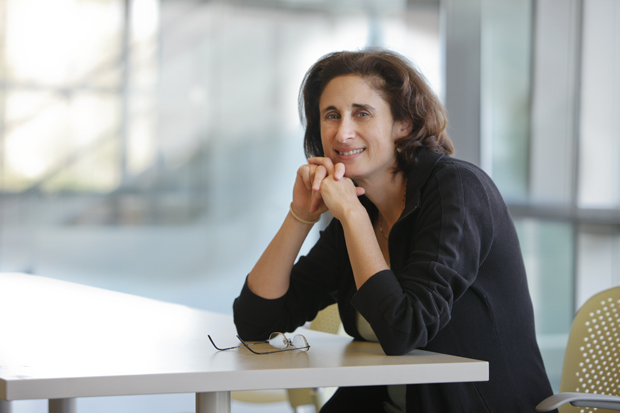Susan Birren reflects on her time as dean of Arts and Sciences
The professor of biology talks about her tenure, Brandeis' future and her return to scientific research.
 Photo: Mike Lovett
Photo: Mike LovettBirren started a pilot program to mentor young faculty members.
Professor of neurobiology Susan Birren stepped down last week as dean of Arts and Sciences.
BrandeisNOW sat down with her to discuss her 7-year tenure and what’s next.
BNOW: You led a major initiative to reform the General Education curriculum for undergraduates. What was the rationale behind that?
Birren: We spent two years thinking about the skills and knowledge that Brandeis students need to make them successful after graduation. We considered critical thinking; the ability to communicate; how well you write; how well you are able to stand up in a room and get your message across; and how you listen to other people’s arguments and maybe even change your mind. We also wanted students to understand that the world they live in is global and diverse and that diversity contributes to a greater understanding of the world.
BNOW: You’ve also focused on the interaction between professors and students.
Birren: One distinctive aspect of Brandeis is that we’re really small given the outstanding caliber of the research faculty we have. When students have the opportunity to interact with those faculty, they have a meaningful experience.
One small program I started is a faculty-student collaboration research grant where two faculty mentors from different departments work with a small number of undergraduates on an interdisciplinary project. A bunch of interesting projects have come through that mechanism.
BNOW: How do you see undergraduate education at Brandeis evolving?
Birren: Science changes so fast, it’s important to think about how to stay on the cutting edge. I'm very pleased about our recent faculty hires in applied math, which is a brand new major at Brandeis. It’s a way of focusing on how the fundamental science we are famous for intersects in exciting ways with applications in the real world. We also need to highlight how studying the humanities provides students with critical analysis skills that drive their success after leaving Brandeis.
BNOW: On the faculty side, you helped start a pilot program for mentoring and supporting junior professors.
Birren: The hope is to demystify the faculty career path, tie young faculty to the university, and provide a community that highlights our collaborative environment. We are trying to develop a more comprehensive view of what it means to be a faculty member and how best to provide mentoring and professional development for young faculty.
The pilot cohort involves junior faculty in the history department and the African diaspora cluster, which allows us to provide mentoring and community to faculty of color. Eventually, I hope that all junior faculty will join a mentoring cohort when they arrive at Brandeis.
BNOW: Increasing faculty diversity has also been a top priority.
Birren: Yes, we have implemented approaches to hiring faculty of color by working with search committees to develop diverse pools of candidates and increase outreach to underserved communities. And once faculty of color are here, how do we provide the resources and create a community that will make them want to stay?
BNOW: What’s been your favorite part of being a dean?
Birren: The most fun part of this job is getting to know the incredibly articulate, smart and argumentative faculty that we have in arts and sciences. Their deep commitment to undergraduate and graduate education and to making this an outstanding research institution is really inspiring.
BNOW: Now you’ll have more time to focus on your research. What are you investigating?
Birren: I’m interested in how events that take place early in the development of an animal can have an impact on aging and disease in the adult. For instance, early interactions between nerve cells and the heart that take place right after birth can set the stage for whether an animal or person will develop high blood pressure later in life. Now that we know that, we can start to ask about the genes and proteins that control those disease processes.
Categories: General, Research, Science and Technology





